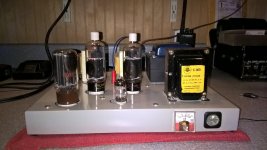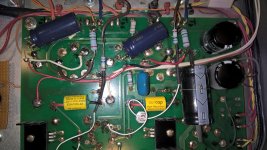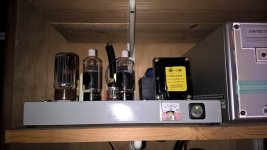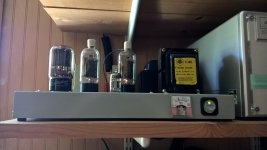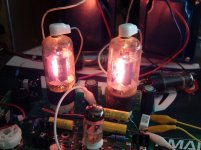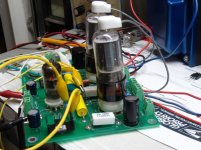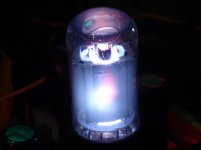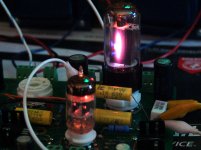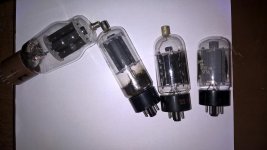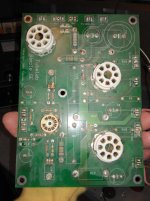I haven't tried it.
But I'm tired of buying these things for a quarter a pop at hamfests and not having a use for them. 6BG6 has the same pinout, to make things more interesting, but they often cost as much as a buck or two.
Once again, due to the unique configuration of the SSE board, I think either would work without cutting any traces. Not quite as simple as dropping 6146/2E26 types on the board, but probably not a lot harder either.
CAVEAT: The SSE board was obviously not intended for this, and I don't have one in front of me, so this is from memory. Proceed at your own risk.
The 6CD6 pinout is 5BT (which, interestingly, was my late grandfather's call sign at one time, but I digress). Anyway, pins 2 and 7 are heaters. 5 is the control grid. The plate goes to a cap, so far so good.
The cathode (tied to the suppressor) is at pin 3 on 5BT. On the SSE baord, pin 3 is brought out to the edge connectors, so it is easily isolated. The cathode resistor and by pass cap would be lifted from their traces nearest the cathode of the power tube, and connected to pin 3.
The screen grid on 5BT is at pin 1. Pin 1 was just isolated on the SSE board, by lifting the cathode resistor and bypass cap as above. Connect pin 1 to wherever it needs to go for triode, ultra linear, or pentode. If 6CD6 is used, it is a sweep tube so a relatively low screen voltage would have to be provided. This is inconvenient, but hardly insurmountable.
6BG6 is, of course, a 6L6 with another pinout.
Like I said, I haven't tried this, i don't have a board in front of me, but it looks like it would work. Whether or not it is a good idea is a separate question. At some point I will try it.
Win W5JAG
But I'm tired of buying these things for a quarter a pop at hamfests and not having a use for them. 6BG6 has the same pinout, to make things more interesting, but they often cost as much as a buck or two.
Once again, due to the unique configuration of the SSE board, I think either would work without cutting any traces. Not quite as simple as dropping 6146/2E26 types on the board, but probably not a lot harder either.
CAVEAT: The SSE board was obviously not intended for this, and I don't have one in front of me, so this is from memory. Proceed at your own risk.
The 6CD6 pinout is 5BT (which, interestingly, was my late grandfather's call sign at one time, but I digress). Anyway, pins 2 and 7 are heaters. 5 is the control grid. The plate goes to a cap, so far so good.
The cathode (tied to the suppressor) is at pin 3 on 5BT. On the SSE baord, pin 3 is brought out to the edge connectors, so it is easily isolated. The cathode resistor and by pass cap would be lifted from their traces nearest the cathode of the power tube, and connected to pin 3.
The screen grid on 5BT is at pin 1. Pin 1 was just isolated on the SSE board, by lifting the cathode resistor and bypass cap as above. Connect pin 1 to wherever it needs to go for triode, ultra linear, or pentode. If 6CD6 is used, it is a sweep tube so a relatively low screen voltage would have to be provided. This is inconvenient, but hardly insurmountable.
6BG6 is, of course, a 6L6 with another pinout.
Like I said, I haven't tried this, i don't have a board in front of me, but it looks like it would work. Whether or not it is a good idea is a separate question. At some point I will try it.
Win W5JAG
Last edited:
Oh:
6CD6 Sweep Tube | Tubelab
George,
Does the series regulator tube drop the screen voltage by the value of the regulator tube?
Win W5JAG
6CD6 Sweep Tube | Tubelab
George,
Does the series regulator tube drop the screen voltage by the value of the regulator tube?
Win W5JAG
yes, but in triode mode the screen voltage attempts to go negative as the plate voltage drops below the VR tube voltage. This causes the VR tube to extinguish killing all plate current. The plate voltage rises quickly striking up the VR tube again.
As you can guess this causes some rather rude sounding distortion.
I was laying out a breadboard full of experiments tonight when my ability to concentrate went to zero, so I shut down Eagle for the night. There is a mosfet based adjustable UL simulator on that board that works without a UL tap on the OPT.
As you can guess this causes some rather rude sounding distortion.
I was laying out a breadboard full of experiments tonight when my ability to concentrate went to zero, so I shut down Eagle for the night. There is a mosfet based adjustable UL simulator on that board that works without a UL tap on the OPT.
I read about that mosfet simulator after I found your page on the 6CD6.
Looking forward to seeing it. I hadn't thought about the series tube until I saw your page. The idea here is to drop the dc voltage, while preserving the ac waveform?
When playing around with some of the smaller tubes, it seemed like *some* could tolerate elevated voltages in UL mode, that would have been unacceptable in triode. I was hoping that 6CD6 might fall in that catagory.
I think some of the other similar big sweeps could be adapted to your board, but the connection between pins 1 and 8 would have to be cut.
At what point does the 12AT7 run out of gas?
Win W5JAG
Looking forward to seeing it. I hadn't thought about the series tube until I saw your page. The idea here is to drop the dc voltage, while preserving the ac waveform?
When playing around with some of the smaller tubes, it seemed like *some* could tolerate elevated voltages in UL mode, that would have been unacceptable in triode. I was hoping that 6CD6 might fall in that catagory.
I think some of the other similar big sweeps could be adapted to your board, but the connection between pins 1 and 8 would have to be cut.
At what point does the 12AT7 run out of gas?
Win W5JAG
Hold the phone .....
The (re) connections above ^^^^^^ described, in fact, work. I have 6CD6 working in the right channel of my SSE right now.
Pentode, schade feedback, screens set for 250 ish. Looks like 6CD6 really wants to pull current, about 95 mils on initial power up. I have a 5R4 rectifier in place, so probably about 30 watts. No color showing in the tube.
This is a bit of a fiddly conversion, and I'm trying to decide whether to do the left side, now that I've satisfied myself that it can be done.
More to follow. Or not.
Win W5JAG
The (re) connections above ^^^^^^ described, in fact, work. I have 6CD6 working in the right channel of my SSE right now.
Pentode, schade feedback, screens set for 250 ish. Looks like 6CD6 really wants to pull current, about 95 mils on initial power up. I have a 5R4 rectifier in place, so probably about 30 watts. No color showing in the tube.
This is a bit of a fiddly conversion, and I'm trying to decide whether to do the left side, now that I've satisfied myself that it can be done.
More to follow. Or not.
Win W5JAG
Both channels done - as I noted, a bit of a fiddly conversion - several flying leads that I am not really a fan of.
Still have the grids set at 100K from running 6146 on the board. Plate is set at 5K, I think.
Screen voltage 238
cathode voltage 40.6; Rk 390 = 104 mils. ( well in excess of my OPT rating ).
Anode voltage 365 - 5R4GYB rectifier
34 watts, a bit more than I estimated. Tubes seem content. Warming the ham shack up nicely.
Win W5JAG
Still have the grids set at 100K from running 6146 on the board. Plate is set at 5K, I think.
Screen voltage 238
cathode voltage 40.6; Rk 390 = 104 mils. ( well in excess of my OPT rating ).
Anode voltage 365 - 5R4GYB rectifier
34 watts, a bit more than I estimated. Tubes seem content. Warming the ham shack up nicely.
Win W5JAG
As much as I like seeing things go up in smoke ( this being the Tubelab forum, after all ), I draw the line at smoking things with laminations, so unfortunately I had to back the power down a bit.
I changed Rk to 560 to drop the current, and plugged in a 5AR4 to boost the anode voltage. Unfortunately, Rk 560 may leave 6BG6 underpowered at this low screen voltage - I didn't bring any 6BG6 home to test.
cathode voltage 43; Rk 560 = 77 mils ( barely within the rating for my OPT's )
Anode voltage 429 - 5AR4 rectifier
30 watts, one 6CD6 shows a lot of orange on a plate wing that I didn't notice until I turned the lights out, the other seems fine. These are black plate Sylvania's. They seem stable.
That's as hard as I hit can these guys, with the board in place on the chassis. Putting diodes in the rectifier tube socket will smoke my 450 volt filter caps, as I have already determined, and I don't feel like changing caps and cleaning up that kind of mess tonight.
Going back to the 5R4 would pull the tubes down to 25 watts with 560 Rk, which should be safe. As I get time, I'll fool with some different rectifiers, or an outboard power supply, and some more 6CD6 samples to get a better envelope on these tubes in the SSE.
Pics later.
Win W5JAG
I changed Rk to 560 to drop the current, and plugged in a 5AR4 to boost the anode voltage. Unfortunately, Rk 560 may leave 6BG6 underpowered at this low screen voltage - I didn't bring any 6BG6 home to test.
cathode voltage 43; Rk 560 = 77 mils ( barely within the rating for my OPT's )
Anode voltage 429 - 5AR4 rectifier
30 watts, one 6CD6 shows a lot of orange on a plate wing that I didn't notice until I turned the lights out, the other seems fine. These are black plate Sylvania's. They seem stable.
That's as hard as I hit can these guys, with the board in place on the chassis. Putting diodes in the rectifier tube socket will smoke my 450 volt filter caps, as I have already determined, and I don't feel like changing caps and cleaning up that kind of mess tonight.
Going back to the 5R4 would pull the tubes down to 25 watts with 560 Rk, which should be safe. As I get time, I'll fool with some different rectifiers, or an outboard power supply, and some more 6CD6 samples to get a better envelope on these tubes in the SSE.
Pics later.
Win W5JAG
I've not had an opportunity to fool with this since last week, but here are a few pics for anyone curious ...
Picture 1 is just a head on shot with the Sylvania 6DC6's on the work bench. One channel is running into a cheap test speaker, the other into a dummy load. There are slight construction differences between the two tubes. One doesn't flinch at 34 watts. The other struggles at 25.
The rating is 20 watts, IIRC.
Picture 2 shows the flying wiring around the power tube bases. I believe this is one of the original SSE boards ( it was my first from 2008 ish (?)) and it clearly shows the evidence of a long, long, hard life - lots of experiments and component "failures". I should probably pull that 450 volt capacitor I scabbed on and replace it with a 500 volt part so I can use more plate voltage.
Picture 3 is just a picture of the amp where it normally sits on a high shelf in my radio room.
Picture 4 shows 6BG6 in place in the amp. The ammeter shows the considersable power difference between the two tube types with identical cathode resistors and screen voltages. Where the 6CD6 are running 25 watts or so with a 5R4 rectifier, the 6BG6 are probably around 17 watts with a 5V4 rectifier. The 6BG6 is a 6L6GA with the 5BT pin out.
Win W5JAG
edit: can't get the files to upload?
Picture 1 is just a head on shot with the Sylvania 6DC6's on the work bench. One channel is running into a cheap test speaker, the other into a dummy load. There are slight construction differences between the two tubes. One doesn't flinch at 34 watts. The other struggles at 25.
The rating is 20 watts, IIRC.
Picture 2 shows the flying wiring around the power tube bases. I believe this is one of the original SSE boards ( it was my first from 2008 ish (?)) and it clearly shows the evidence of a long, long, hard life - lots of experiments and component "failures". I should probably pull that 450 volt capacitor I scabbed on and replace it with a 500 volt part so I can use more plate voltage.
Picture 3 is just a picture of the amp where it normally sits on a high shelf in my radio room.
Picture 4 shows 6BG6 in place in the amp. The ammeter shows the considersable power difference between the two tube types with identical cathode resistors and screen voltages. Where the 6CD6 are running 25 watts or so with a 5R4 rectifier, the 6BG6 are probably around 17 watts with a 5V4 rectifier. The 6BG6 is a 6L6GA with the 5BT pin out.
Win W5JAG
edit: can't get the files to upload?
Attachments
Last edited:
and it clearly shows the evidence of a long, long, hard life - lots of experiments and component "failures".
One of mine looks about the same. It's seen about 5 years of experiments, and lots of fried parts. It was the one I used to blow up some gassy 6V6GT's when the cathode bypass cap spewed its guts. 80 volts across a 50 volt cap doesn't go well. I scrubbed it down with WD40 and a tooth brush and kept on using it. It was used for all of my extreme experiments. It's in a box somewhere.
Oddly enough, I don't even have a tube amp hooked up yet, but I have moved twice in the past 16 months. My favorite SSE got dropped, and doesn't work an more. Guess I need to make a new one.
Two pictures of gassy 6V6GT's, and three pictures of some 6BQ6's. You thought only the Chinese made crooked tubes. This one was dubbed the leaning tower of power. (trivia question....what popular automobile engine shared the same name?)
They worked, so I put in a set of crusty old tubes, and explored the upper limits of power. They worked too.......for a while.
Attachments
I haven't tried it.
But I'm tired of buying these things for a quarter a pop at hamfests and not having a use for them. 6BG6 has the same pinout, to make things more interesting, but they often cost as much as a buck or two.
Win W5JAG
Well! You guys over there are lucky to have those kind of prices. Over here in Canada used ones
would probably go for $5 or more at the few hamfests we have over here. I usually get my tubes
from online suppliers mostly in the USA.
I've used the 6BG6 with a socket adaptor in both my high power and low power SSE's.
I have eight of them and all but two tend to red plate in my high power SSE with a B+ of around 450V.
In my low power SSE with these tubes I get a B+ of around 365V they play and sound very good, no
red plating at all.
I doubt I'll be trying the 6CD6 as I'm leery of fiddling with the board.
Yes, good point, there are tube adapters for sale on ebay that do make 6BG6 plug and play in the SSE, for those that don't want to do it at the board level.
I have to confess that I haven't paid a lot of attention to 6BG6, since I didn't have anything that used them. Do all of yours have the same plate structure?
Although the picture I posted doesn't show the tubes very well, those GE 6BG6GA in the SSE sure look like a black plate GE 6L6GC to me. I swung by my warehouse of junk this evening and grabbed another pair of 1963 manufacture Westinghouse 6BG6GA ( and a 10 volt filament transformer - still toying with the idea of 801's in the TSE ) and they also look like 6L6GC with a cap.
I know some 807's made it out of the factories with 6L6GC guts, because I have some. And there are the Sylvania JAN 6BG6GA with 7027 guts that WB0SND is selling ( I saw Mike at a hamfest this summer and IIRC, he said he has sold through a lot of his invenory of those ).
If I think about it, I'll try to dig out some 6AL6G to compare mine to. 6AL6G is an obscure 6L6 type - it is a true 6L6G, but with the plate brought out to a cap. They are really scarce, at least in my experience. Perhaps it was replaced by the 6BG6G/GA for some reason.
Win W5JAG
I have to confess that I haven't paid a lot of attention to 6BG6, since I didn't have anything that used them. Do all of yours have the same plate structure?
Although the picture I posted doesn't show the tubes very well, those GE 6BG6GA in the SSE sure look like a black plate GE 6L6GC to me. I swung by my warehouse of junk this evening and grabbed another pair of 1963 manufacture Westinghouse 6BG6GA ( and a 10 volt filament transformer - still toying with the idea of 801's in the TSE ) and they also look like 6L6GC with a cap.
I know some 807's made it out of the factories with 6L6GC guts, because I have some. And there are the Sylvania JAN 6BG6GA with 7027 guts that WB0SND is selling ( I saw Mike at a hamfest this summer and IIRC, he said he has sold through a lot of his invenory of those ).
If I think about it, I'll try to dig out some 6AL6G to compare mine to. 6AL6G is an obscure 6L6 type - it is a true 6L6G, but with the plate brought out to a cap. They are really scarce, at least in my experience. Perhaps it was replaced by the 6BG6G/GA for some reason.
Win W5JAG
Chrysler slant 6?
Yes. I must have owned at least a dozen Darts, Valiants, Dusters, and even a Coronet, all with slant 6 power in all three displacements, 170, 198 and 225 cubic inches. Despite my continued attempts, I never could blow one up.
Ran one without water until it quit (2AM on a very rural road). Exhaust manifold was glowing like a tube plate. A dozen or so Dairy Queen cups full of canal water....and I was back on my way. Changed the bypass hose the next morning, and the Coronet never looked back.
I would drive the 65 Dart until the oil light lit up, dump in a quart, and keep going. Myself and both my brothers learned to drive in that car. I know it survived hundreds of neutral drops, and a few reverse to drive to reverse in the mud with the accelerator on the floor. It was still running when we sold it with 170K miles. I can only remember changing the alternator and the water pump.
I have seen some 6BG6GA's with 6L6GC guts in them. I gave them away though. I think I had 3. They were distinctly different from the SND 7027 based tubes. I believe that they were RCA's, but maybe GE's.
I have seen 807's with just about everything related to the 6L6 inside them. When I got the lot of 100,000 tubes, there were about 1000 807's and 1625's. Over half of them were broken, so I took several apart.
Yes, good point, there are tube adapters for sale on ebay that do make 6BG6 plug and play in the SSE, for those that don't want to do it at the board level.
I have to confess that I haven't paid a lot of attention to 6BG6, since I didn't have anything that used them. Do all of yours have the same plate structure?
Win W5JAG
I have 4 RCA and 2 Sylvania 6BG6G's, these all have similar plate structure, the other two are Philips/ECG (Sylvania) 6BG6GA I got from SND,
these have a larger plate structure and these are the ones that don't red plate in my high power SSE.
Left to right:
The obscure 6AL6G, which is a true 6L6G with the plate brought out to a cap. Note the cap is the small size associated with early TV sweep tubes like 6BQ6 and 6DQ6.
Next, a Westinghouse manufacture 6BG6GA - clearly I was crazy last night, this looks nothing like a 6L6GC, and looks wimpy compared to even the 6AL6G.
Third, the GE 6BG6GA. Sure looks like a GE blackplate 6L6GC to me, right down to the grid fins on top of the tube.
Fourth, I couldn't get a good picture of a blackplate GE 6L6GC - all of mine have too much getter flash to photograph at the right angle - so here is a grey plate GE 7581A/KT66. The grid fins are more robust, but the plate structure looks comparable.
Of course we cannot see the cathodes in any of these.
Win W5JAG
The obscure 6AL6G, which is a true 6L6G with the plate brought out to a cap. Note the cap is the small size associated with early TV sweep tubes like 6BQ6 and 6DQ6.
Next, a Westinghouse manufacture 6BG6GA - clearly I was crazy last night, this looks nothing like a 6L6GC, and looks wimpy compared to even the 6AL6G.
Third, the GE 6BG6GA. Sure looks like a GE blackplate 6L6GC to me, right down to the grid fins on top of the tube.
Fourth, I couldn't get a good picture of a blackplate GE 6L6GC - all of mine have too much getter flash to photograph at the right angle - so here is a grey plate GE 7581A/KT66. The grid fins are more robust, but the plate structure looks comparable.
Of course we cannot see the cathodes in any of these.
Win W5JAG
Attachments
My wife and three year old are at our other house, so I've had a bit more time to play with this tonight.
I cleaned up some of my flying leads, moving the screen series resistance closer to the screen pin on the power tube, and increased the grid resistors back to the 220K SSE specification. I disconnected the 450 volt filter cap that I had scabbed on the board, so I can raise the plate voltage.
I left the screen voltage where it was - lower might be better for 6CD6, but I want to preserve the option to torment 6BG6 without having to melt solder on the screen board.
I brought home some NOS, but horribly crooked, GE 6CD6, one with solid gray plates, and one with round apertures in the plate, also a gray plate, to "test".
With a solid state device in the rectifier tube socket, I measured 483 volts at the plate cap of the 6CD6 tube. subtracting out the cathode voltage, that makes 440 volts across the tube, or 34 watts at 77 ma cathode current. My power supply can produce a lot more current, easily, but I'm at the ragged edge of my OPT's where I'm at.
Neither of these GE 6CD6's show any color in a dark room. 3 out of 4 of the 6CD6 I've tried, handle this power easily. Not bad for twenty watt tubes that are dirt cheap.
Win W5JAG
I cleaned up some of my flying leads, moving the screen series resistance closer to the screen pin on the power tube, and increased the grid resistors back to the 220K SSE specification. I disconnected the 450 volt filter cap that I had scabbed on the board, so I can raise the plate voltage.
I left the screen voltage where it was - lower might be better for 6CD6, but I want to preserve the option to torment 6BG6 without having to melt solder on the screen board.
I brought home some NOS, but horribly crooked, GE 6CD6, one with solid gray plates, and one with round apertures in the plate, also a gray plate, to "test".
With a solid state device in the rectifier tube socket, I measured 483 volts at the plate cap of the 6CD6 tube. subtracting out the cathode voltage, that makes 440 volts across the tube, or 34 watts at 77 ma cathode current. My power supply can produce a lot more current, easily, but I'm at the ragged edge of my OPT's where I'm at.
Neither of these GE 6CD6's show any color in a dark room. 3 out of 4 of the 6CD6 I've tried, handle this power easily. Not bad for twenty watt tubes that are dirt cheap.
Win W5JAG
One of mine looks about the same. It's seen about 5 years of experiments, and lots of fried parts. It was the one I used to blow up some gassy 6V6GT's when the cathode bypass cap spewed its guts. 80 volts across a 50 volt cap doesn't go well. ....
Learned that lesson, that's why those 50 volt bypass caps are aimed off the board ....
Look at how cooked that 12AT7 socket looks. It takes a LOT of hours to do that to a socket, and yes, this board has seen them. Tens of thousands, probably.
The snarf in the rectifier tube keyway is from Bendix rectifiers. NOS ones exude snarf for a period of time.
This SSE board will be washed and put back to stock configuration, parts tested and replaced where necessary, filter caps pulled, and go on some type of breadboard, yet to be devised, for use with some external power supplies, for more abuse.
Win W5JAG
The snarf in the rectifier tube keyway is from Bendix rectifiers. NOS ones exude snarf for a period of time.
This SSE board will be washed and put back to stock configuration, parts tested and replaced where necessary, filter caps pulled, and go on some type of breadboard, yet to be devised, for use with some external power supplies, for more abuse.
Win W5JAG
Attachments
This SSE board will be washed
Do you still put those things into the dishwasher? With dishwasher detergent?
I don't remember if my real nasty board made the move last year or not. I sold (hamfests from Florida to Dayton), gave away, or tossed more than half of my "stuff" before moving. I still can't find things.
My "Industrial" SSE got dropped. Fortunately it landed upside down and the point of impact was on the big fat motor run cap which sprung an oil leak and was tossed. I haven't decided whether to scrap it and make a new one, or rebuild it. The chassis was glued together with JB weld, which broke loose in some places.
- Status
- Not open for further replies.
- Home
- More Vendors...
- Tubelab
- 6CD6 in the SSE
